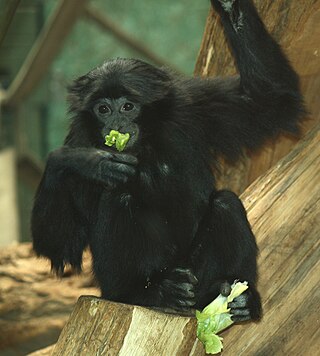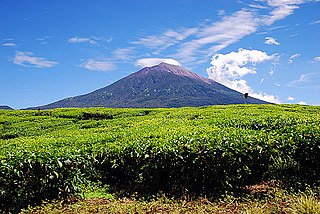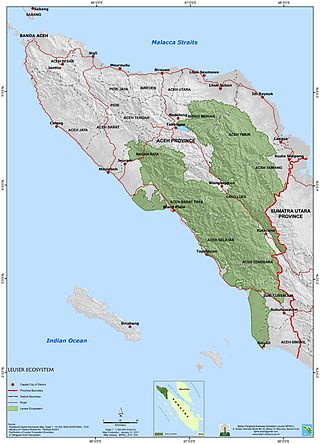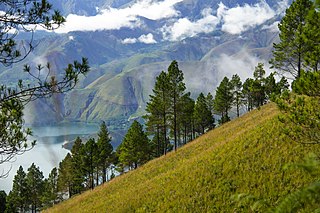
Sumatra is one of the Sunda Islands of western Indonesia. It is the largest island that is fully within Indonesian territory, as well as the sixth-largest island in the world at 475,807.63 km2 (182,812 mi.2), including adjacent islands such as the Simeulue, Nias, Mentawai, Enggano, Riau Islands, Bangka Belitung and Krakatoa archipelago.

In Indonesian folklore, the Orang Pendek is the most common name given to a creature said to inhabit remote, mountainous forests on the island of Sumatra. The creature has allegedly been seen and documented for at least 100 years by forest tribes, local villagers, Dutch colonists, and Western scientists and travelers. Consensus among witnesses is that the animal is a ground-dwelling, bipedal primate covered in short fur, standing between 80 and 150 cm tall.

The siamang is a endangered arboreal, black-furred gibbon native to the forests of Indonesia, Malaysia, and Thailand. The largest of the gibbons, the siamang can be twice the size of other gibbons, reaching 1 m (3.3 ft) in height, and weighing up to 14 kg (31 lb). It is the only species in the genus Symphalangus. Fossils of siamangs date back to the Middle Pleistocene.

Mount Kerinci is an active stratovolcano and the highest mountain in Sumatra, Indonesia. At 12,484 ft (3,805 m) above sea level, it provides Sumatra with the fifth-highest maximum elevation of any island in the world. It is surrounded by the lush forest of Kerinci Seblat National Park, home to several endangered species including the Sumatran tiger. Mount Kerinci is ranked 32nd by topographic isolation.

The Bukit Barisan or the Barisan Mountains are a mountain range on the western side of Sumatra, Indonesia, covering nearly 1,700 km (1,050 mi) from the north to the south of the island. The Bukit Barisan range consists primarily of volcanoes shrouded in dense jungle cover, including Sumatran tropical pine forests on the higher slopes. The highest peak of the range is Mount Kerinci at 3,800 metres (12,467 ft). The Bukit Barisan Selatan National Park is situated towards the southern end of the range in Liwa, Indonesia.

The Sumatran tiger is a population of Panthera tigris sondaica on the Indonesian island of Sumatra. It is the only surviving tiger population in the Sunda Islands, where the Bali and Javan tigers are extinct.

Gunung Leuser National Park is a national park covering 7,927 km2 in northern Sumatra, Indonesia, straddling the border of Aceh and North Sumatra provinces, a fourth portion and three-fourths portion, respectively. The national park, settled in the Barisan mountain range, is named after Mount Leuser (3,119 m), and protects a wide range of ecosystems. An orangutan sanctuary at Bukit Lawang is located within the park. Together with Bukit Barisan Selatan and Kerinci Seblat National Parks, it forms a World Heritage Site, the Tropical Rainforest Heritage of Sumatra.

The Sumatran striped rabbit, also known as the Sumatra short-eared rabbit or Sumatran rabbit, is a rabbit found only in forests in the Barisan Mountains in western Sumatra, Indonesia, and surrounding areas. It is threatened by habitat loss.

Kerinci Seblat National Park is the largest national park on the island of Sumatra, Indonesia. It has a total area of 13,791 km2, and spans four provinces: West Sumatra, Jambi, Bengkulu, and South Sumatra.

The Sumatran ground cuckoo is a large, terrestrial species of cuckoo. It was introduced to Western science in 1879 and was formerly considered conspecific with the Bornean ground cuckoo but was given status as a unique species in 2000. This elusive species was initially known from just eight specimens and evaded notice from 1916 until 1997, when it was rediscovered and photographed by Andjar Rafiastanto. The Sumatran ground cuckoo's diet is thought to consist of invertebrates, small mammals, and reptiles.

Bukit Barisan Selatan National Park is a national park in Sumatra, Indonesia. The park located along the Bukit Barisan mountain range, has a total area of 3,568 km2, and spans three provinces: Lampung, Bengkulu, and South Sumatra. Together with Gunung Leuser and Kerinci Seblat national parks it forms a World Heritage Site, Tropical Rainforest Heritage of Sumatra.

The Sunda clouded leopard is a medium-sized wild cat native to Borneo and Sumatra. It is listed as Vulnerable on the IUCN Red List since 2015, as the total effective population probably consists of fewer than 10,000 mature individuals, with a decreasing population trend. On both Sunda Islands, it is threatened by deforestation. It was classified as a separate species, distinct from the clouded leopard in mainland Southeast Asia based on a study in 2006. Its fur is darker with a smaller cloud pattern.
Wijayarana modiglianii is a species of frog in the family Ranidae. It is endemic to Sumatra (Indonesia). It was originally only known from two locations near Lake Toba, but is now known to be more widespread. The specific name modiglianii honors Elio Modigliani, an Italian anthropologist and zoologist who collected the holotype in 1891. Common name Modigliani's huia frog has been coined for this species. Morphological evidence suggests that it can hybridize with Huia sumatrana, but this needs confirmation using genetic data.

The Leuser Ecosystem is an area of forest located in the provinces of Aceh and North Sumatra on the island of Sumatra in Indonesia. Covering more than 2.6 million hectares it is one of the richest expanses of tropical rain forest in Southeast Asia and is the last place on earth where the Sumatran elephant, rhino, tiger and orangutan are found within one area. It has one of the world's richest yet least-known forest systems, and its vegetation is an important source of Earth's oxygen. Leuser also possesses more lowland rainforest than the rest of Sumatra combined and supports some of the last viable populations of tiger, rhino, orangutan and elephant.

The Sumatran tropical pine forests is a tropical coniferous forest ecoregion on the island of Sumatra in Indonesia.

The Sumatran clouded leopard is a subspecies of the Sunda clouded leopard and is native to the Indonesian islands of Sumatra and Batu. It differs in molecular, craniomandibular and dental characteristics from the Bornean clouded leopard. It was recognized as a valid subspecies in 2017.

The Sumatran lowland rain forests ecoregion covers the lowland forests running the length of the island of Sumatra in Indonesia. The region is one of exceptionally high biodiversity, similar to Borneo and New Guinea islands. Many endangered mammals species are present, and over 450 species of birds have been found in the region. In recent years, illegal logging and human encroachment have put great strain on this ecoregion.

The Sumatran montane rain forests ecoregion covers the mountainous elevations of the Barisan Mountains Range that runs the length of the southwestern side of the island of Sumatra in Indonesia. The ecoregion is almost completely surrounded by the lower elevation Sumatran lowland rain forests. The area is one of very high biodiversity - because of the relative isolation, and variety of forest types, there are 7 endemic species of mammals and eight endemic species of birds.

The western Sumatran rhinoceros is a subspecies of the Sumatran rhinoceros that is native to Sumatra, primarily within these Indonesian national parks: Bukit Barisan Selatan National Park, Kerinci Seblat National Park, Mount Leuser National Park, and its population is partially remaining in Way Kambas National Park. The subspecies went extinct in the Malaysian Peninsula. Its population is limited, with only around 275 rhinos left in the wild, from which they are being threatened by poaching, and occasional habitat loss. A few individuals are being held and bred in captivity within the Sumatran Rhino Sanctuary, and in the Cincinnati Zoo and Botanical Garden.



















